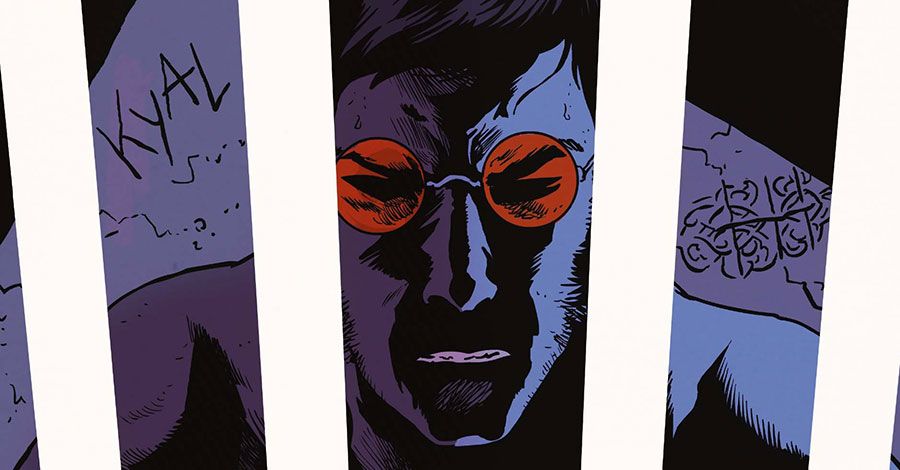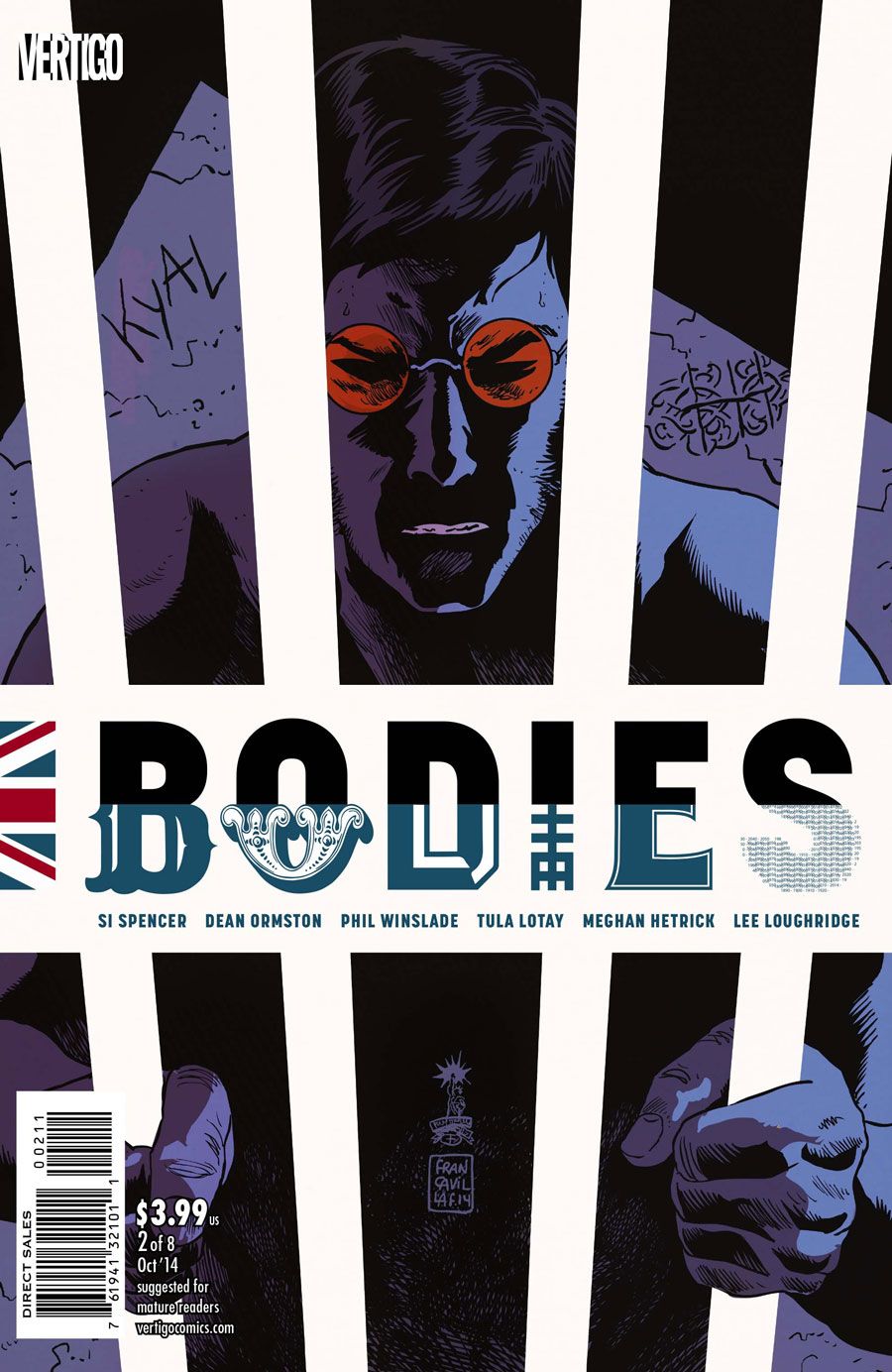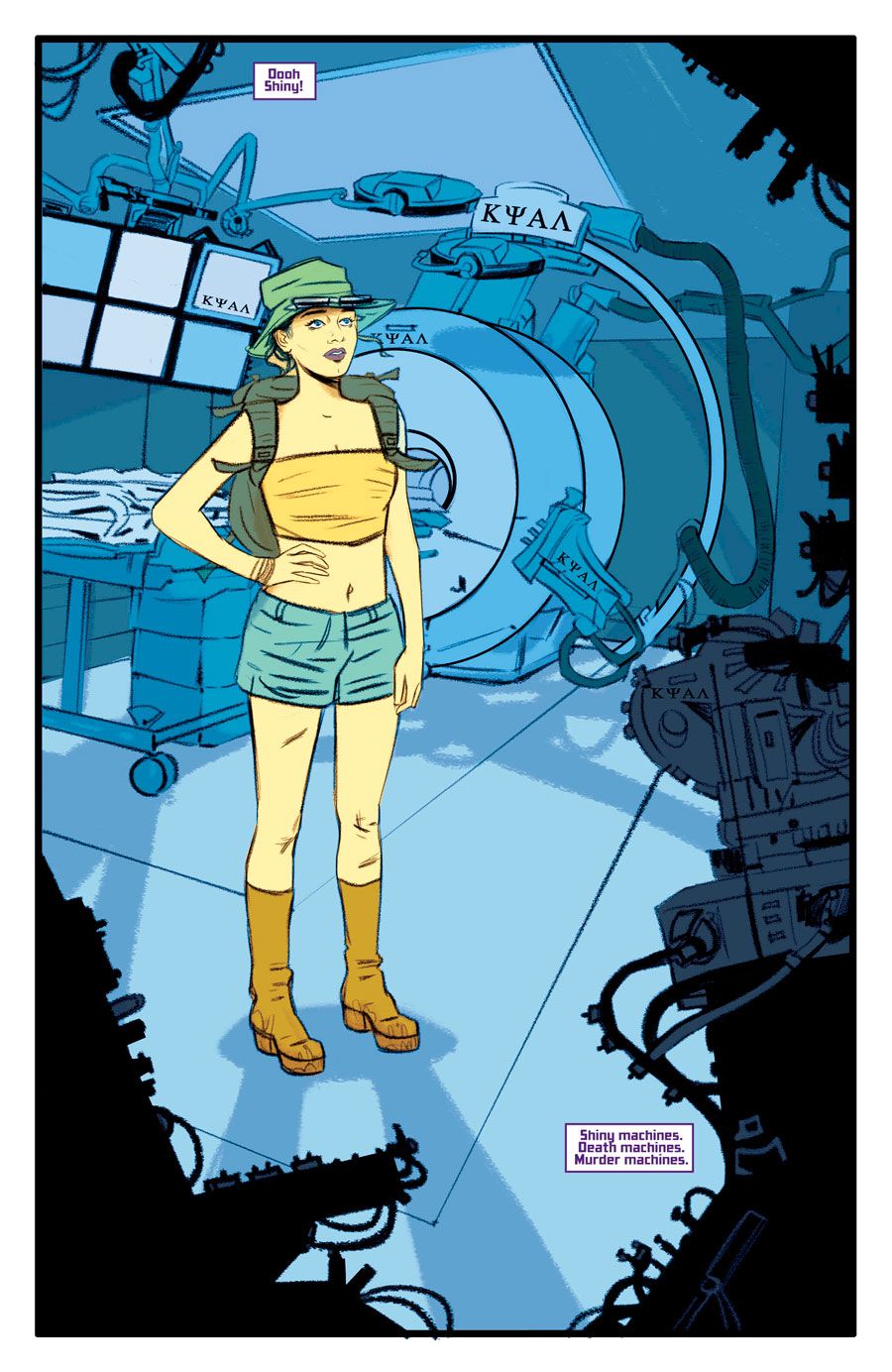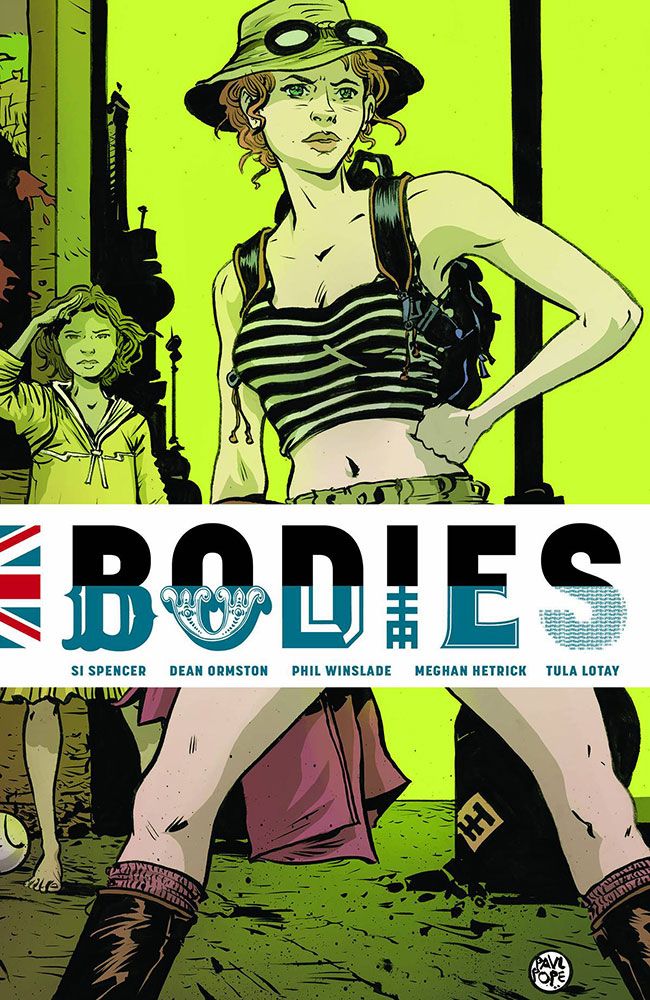Writer Si Spencer told CBR News that he was blown away by the overwhelmingly positive response he received for "Bodies" #1, released last month by Vertigo Comics, and teased that the centuries-spanning murder mystery expands even further beyond space and time next week with the series' second issue.
With four detectives, four time periods and four dead bodies -- drawn by artists Dean Ormston, Phil Winslade, Meghan Hetrick and Tula Lotay each and every issue -- the writer shared insight into the secret origin of "Bodies," dissected the very construct of time travel as a writer's tool and revealed that even though it's been announced as an eight-issue limited series, the concept is not unlike "True Detective," meaning more stories can be told within the world despite this particular story having a defined beginning, middle and end.
CBR News: Si, obviously with four timelines and four casts of characters, this a much larger construct than most comics. How did you develop the concept and was it was always split into four storylines?
Si Spencer: I've dreamed story and character and scenes before now, but this is the first time I've ever woken up with just a pitch without a single idea of story or characters. Fortunately, the pitch kind of defines the structure but initially I'd planned on only having three time periods and characters with the idea of introducing a fourth at the end of the book. In discussion with [Vertigo Executive Editor] Shelly Bond and the various powers-that-be, a synchronous note came back suggesting opening with exactly what I had planned for the fourth element and I'm way too superstitious to ignore that kind of serendipity -- not to mention way too smart to turn down a really good note just because I didn't think of it.
Your leading characters are detectives. Sherlock Holmes, Hercule Poirot and Batman all lay claim to the title "World's Greatest Detective." Who would you want investigating your murder?
Why, what have you heard? Is this about the death threats? [Laughs]
Seriously though -- that's a great question couched in a really challenging way. On a literal level, if I do end up getting wacked, it's most likely to be by an extremist idiot, so I don't think anyone will have too much trouble tracking them down. On a literate level though, which I guess is what you're really asking, I think I'd like the whole enquiry to be fun, so maybe Adrian Monk or the little known but hugely enjoyable Gervase Fen. I kind of like the idea of Adrian Monk trying to plough through the chaos of my life.
And if I had to choose one of the cast of "Bodies," I'd choose Shahara -- she's probably the best cop.
We've only seen one issue and you obviously don't want to give away too much just yet, but what connects these four storylines beyond the dead body at the center of each one?
While there's a self-contained narrative in each issue for each character and an overriding arc for each over the eight issues, they're all pieces of a single much bigger story and those connections will become clearer and more overt as we go on. At the moment it's a little like reading a novel through a kaleidoscope, but I'm going to keep turning the lens until it all fits together.
Will we see the four stories crossover? Not meaning time travel, though that would be cool, but will there be recognition of what's happened in the past?
If you read "Bodies" #1 often and closely enough, you'll see that the stories are already crossing over, but that will become more apparent as we unpeel the onion, I promise. And it's interesting that you mention time travel because the possibility of that was one of my first questions, too -- but then I realized there was this much simpler invention called "history." The only time machine you need to research Jack the Ripper, ancient Egypt or Genghis Khan is a book so look out for some research on the part of our characters.
Then there's the question of defining time travel itself -- science fiction often gets very bogged down in a very prosaic linear mechanical model of transport. The TARDIS is essentially a funny shaped car with extraordinary specs but does time travel even need a vehicle? In a quantum world filled with chaos theory and chaos magick where a single electron may exist simultaneously at every time and point in space why would you need a glorified truck? Is a ghost a present day person seeing a vision of the past? Or a time traveller jaunting forward in time to observe us? And what about past life regression, shamanic journeying, astral planes? Is that time travel? Has that got anything to do with the book? Maybe, maybe not.
Okay. You've just blown my mind. Moving beyond the possibility of time travel, I love that you have four artists illustrating the four distinct timelines. Again, was that always the plan or did the one artist per story transpire organically?
Glad you like it -- in retrospect it seems that four incredible but very different artists and one truly extraordinary colorist is absolutely the only way to make this book work, but I didn't realize that when I suggested it. The idea came because it quickly hit me that the only way I could keep any kind of grip on this insanely complex narrative was to set limits, rules and restrictions. The first restriction I set was the six pages per issue per story rule and once that was in place, the idea of bringing a totally different look to each just seemed a logical progression.
Having gone through the mental process of having to inhabit each world and immerse myself in every character, it now seems blindingly obvious that it would be inhuman to ask an artist to do the same. Artists really work hard, you know? They can't just sit at the bar typing insane shit, laughing manically to themselves as the beers keep flowing knowing they can rely on someone else to pull their ass out of the fire. And they've done a brilliant job -- normally in a book I'm more than happy to let my artist make all the key visual decisions, but for obvious continuity reasons I had to be a lot more dictatorial on "Bodies" and they've all been extraordinarily patient in checking their egos for the greater good of the narrative.
In 1890, we meet Edmond Hillinghead, who has a very Sherlock Holmes-ian feel to him. In our short time with him in the first issue, he doesn't appear to be the purest of heroes. Is it fun writing a leading man who lacks some of qualities we expect after reading "The Hero with a Thousand Faces"?
I think when we first meet Edmondm, he's very much a fanboy rather than an expert -- he's a younger detective who nobody takes seriously because of his obsession with this author whose work probably sounded like science fiction to the older generation of cops. In 1890, Holmes is a relatively new phenomenon -- Conan Doyle is very much rising high on his "early pop hits." What was fascinating to me about the year 1890 was that at the time the Jack the Ripper investigation was still very much open -- people forget that there was a long period before anyone declared the killings as "unsolved." The idea that the Ripper was considered still at large at the very moment that someone was writing a set of fictional guidelines for forensic investigation was the big hook for me.
Of the four main characters, we spent the least amount of time with Inspector Whiteman in the first issue. What can you tell us about him and will that pattern continue in coming issues, or will his story and his secrets be more deeply explored moving forward?
[Laughs] Forgive the laughter, but I've read so many reviews, blogs and forums in the last week and I've seen this said of every time period at least once: "We spend less time with this character."
Like I said, it's a strict six pages per story. Everyone gets the same airtime except Edmond in "Bodies" #1 because of the cutaway. Whiteman actually gets the second highest panel count after Maplewood and Maplewood's count is only so high because there's no-one else in her story 'til the last page. On bad days, I feel like maybe it means I haven't served one of my characters as well as the rest, on good days I figure that if everyone disagrees on who's getting the raw deal it's probably in the eye of the beholder.
But in answer to your question though, there's a lot more of good old Uncle Karl to come. Obviously I'm not going to give anything away, but I will give you the teaser that I've never been so terrified of one of my own creations than I am of that man. From purely a writing perspective, he's one of those perfect, rare creations you come across who refuse to do what you tell them. You can't manipulate or cheat a motivation for Karl to do something you want him to -- you just have to change the story to suit his demands. Did I mention writing this book sent me a little crazy?
You already said that you think she is the best detective in "Bodies" and so far I agree. Revealed in 2014, Shahara Hasan is a powerful, powerful character. Who inspired D.S. Hasan, as she seems quite different and more polished than the other three characters?
"Polished"? Interesting choice of adjective -- I think again that may be an issue of perception. It's not just the use of artists that hammers home the differentiation between periods. It was essential, in fact totally natural, to me that each character had an authentic period voice. As a result, there's an inevitable linguistic disconnect between them and a contemporary reader which probably makes Shahara inevitably an easier, slicker character to run with.
The inspiration came from those first abstract lists of themes, concepts and issues that you make for a project. In this case, the radicalization of young Muslims, the rise of the extreme right wing, the culture of terrorism. There are way too many narratives where bold well-meaning brave white men stick out their necks to save the oppressed. I wanted to write a character who strode two cultures equally and was proud of their achievements, but at the same time was critical of the failings of both.
And once that idea took root, it became personal. Someone I knew was killed in the 7/7 bombings on the bus that I regularly took into town. Shahara Islam was a beautiful funny Muslim woman. For eight years, I wore her favorite shirt every July 7th because the last thing she ever said to me was how much she liked it. It's been getting tattier and tattier so in a way this entire book is just a way to pay an even bigger tribute to her so I don't have to keep wearing it. Her uncle said in her obituary: "She was an Eastender, a Londoner and British, but above all a true Muslim and proud to be so." I figured -- that's your character definition, right there.
What makes Shahara tick and why was she the right brand of detective to represent the present day?
In terms of Shahara, I was looking for the epitome of everything that sums up being British in her specific slice of the timeline. Even more so than America, Britain has always been a nation of assimilation, occupation, cultural absorption and mongrelization. We've been multicultural as far back as our history extends, our capital city was built by invaders and has always been a crucible of racial, national, religious and cultural fusion -- it's never been solely "white English" because that concept doesn't even exist. So who better to represent London 2014?
Finally, 36 years in the future, we have Maplewood, who is an all-together different character from the other three. While her amnesia brings a sense of comic relief to another wise gruesome tale is there more to her affliction that we will discover during the series?
The key phrase there I guess is 'her' amnesia, but no spoilers except to say that I didn't give her a bow and arrow in the opening panel by chance -- there are a few visual and verbal clues to what might have happened, but I kept them very low-key like the bow and arrow. I deliberately wanted to create six pages that were baffling in the first issue. Given that the parameters of the high concept meant that I had to repeat a certain amount of narrative real estate with images of The Corpse, I figured that at least a portion of the opening chapter should be absolutely chock-a-block with questions. And of course I'll start answering those questions right away in the next issue.
And yes, there's a lot of humor in there, but I hope there's a little pathos, bathos and tragedy too. I'm channeling a little of my experience of loved ones with Alzheimer's in there. Of course on a practical level, there was that tricky 'history' angle to deal with -- I didn't want my future character to be able to access the information of her three predecessors too easily.
You don't want to give away the ending, obviously, but "Bodies" is a limited series with a, one would guess, defined ending. But the same can be said of HBO's "True Detective," which is currently prepping its second series despite the storyline for the first season coming to an end. Is there a way to continue "Bodies" beyond the eight issues that have been announced?
This book may have driven me insane, but it hasn't made me stupid. It's a very bold and financially unwise writer who kills off his favorite babies if there's the slightest glimmer of a sequel or spinoff. Every character's story will have a satisfactory end point, the over-riding arc will be fully explained but that doesn't mean I'm shutting down all the characters or the concept for good. The logical extension of the very crux of the concept means that this book and/or its characters can go almost anywhere -- I already have a notebook full of ideas for where we go next. Which is just one really great reason for everyone to buy the book.
"Bodies" #2, by Si Spencer and illustrated by Dean Ormston, Phil Winslade, Meghan Hetrick and Tula Lotay, is on sale August 27.




